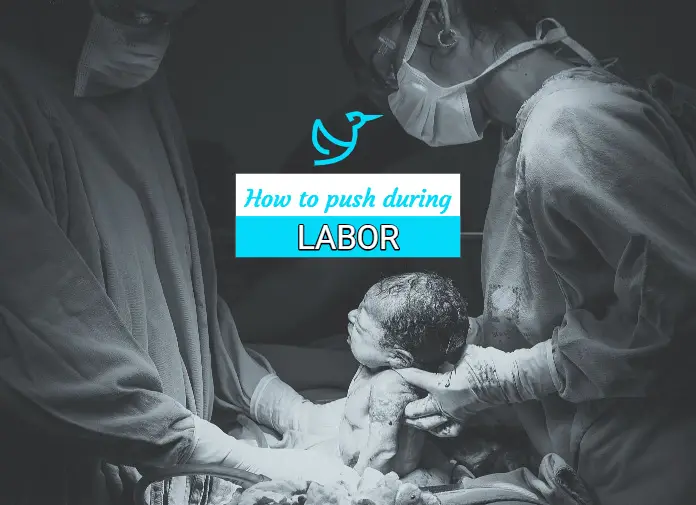For pushing during labor follow count of 10 when you get a muscle signal. Set yourself in the birthing position comfortable for you like bent on knees. Keep pushing and breathing deeply. As soon as you count “… 8, 9, 10..” just stop pushing. Don’t let the urge make you continuously push as it could tear your vagina.
How to push your baby out is the biggest pregnancy dilemma for first-time mums. Taking the assistance of doula or labor coach eases the mental exercise. The coach will take up counting and judging the right time for pushing.
Pushing during labor is a fine-tuning of the pause and fast forward. The hold and pause are equally crucial for preventing tearing of cervix.
Here is the post that will lay all the things in front of you clear and nice and enable you to make the right choice. Lay back mammas we got your back! ?

What are the ways of pushing during labor?
Two theories about pushing the baby out are prevalent. One being the pushing as instructed by your birth assistant and second, being your boss and following instincts.
Coached pushing or Old school and spontaneous pushing are the two methods. Latest practice is the coached pushing acknowledging mother’s instincts – blending the two ways.
Researches on neonatal outcome of ways of pushing have been conducted over and over. Most show that no conclusions can be made about which way of pushing during labor is best. 1
Which method for pushing during labor is better: Coached or Spontaneous?
None of the two are wrong, and you can choose between them judging the best for you. If you’re nervous and not able to tap your gut feeling as you’re turning into a seal shrieking ask for help!
Spontaneous pushing has risks of tiring yourself, vaginal laceration, and unsatisfactory experience. Need for surgical or assisted birth methods after coached pushing was more commonly reported. Even after endless studies and experiments, there is no definite answer to which is the best way to push.
When will you know it’s time to push?
Before heading on to how you need to know when your role begins. A quick brief of what happens at the moment of delivery. No, it’s not going to be scary as in the movies.
Your mucus plug came out, and your cervix began dilating. The early labor is over, and now the cervix is fully open. It’s time for rendezvous with the contractions that you falsely felt at 2 am the other day.
Feelings at the time of pushing are just like the bowel movements. So you will feel the baby’s head pushing down there.
Here are a few other things you will during the pushing stage:
- A burning, stretching, or almost snapping off feeling in the vagina as the baby’s head bulges out.
- Uterus contractions become mild but localized extremely low. Muscle mind connection will even make you feel rising and detaching of the uterus.
- A pressure in your rectum that causes oops moments
- A slippery parcel flowing down your vagina making it feel warm inside and cool outside
- Blood and more blood all over
For women on epidural, the pressure without pain feeling is misguiding. Don’t let that make you push incessantly. That’s hazardous for everything from your vagina, to state of consciousness.
What happens during the pushing stage?
Until here it’s all the same whether you go for coached birthing or DIY. Now if you’ve decided to let your body be your coach, then you can start pushing to the count of 6-10. Hold.
Breathe deeply, as taught in the Lamaze classes. Again when your body tells you to push after a pause. Remember the pause is equally essential.
What happens after the pushing stage?
Baby’s head is the widest part. Once it’s out, the doctor sucks off the mucus-filled the in the nose. Rest of the body comes out almost immediately.
Cord clamping and cut takes place. Skin to skin is the next recommended step. You will have to push one more time and the third stage of labor – placenta delivery takes place.
Now baby’s bath and APGAR score will be done while you will rest and recover.
How to decide when to push during labor?
At least be at ease that the pushing stage doesn’t involve any unbearable pain. You will not be able to lay back either. There is a feeling of discomfort in the lower body which you’d want to get rid of. Baby’s head presses the nerves in the area sending brain signal to push her out.
Many women compare it with the feeling of bowel movements. Those who go under the impression of bowel movements are shocked (as expected). When you respond to bowel movement, you are engaging an altogether different set of muscles.
You can try imagining holding something with the vagina squeezing it. The muscles or abs which participate along are the ones. Try practicing these moves whenever you can.
A study conducted showed that women who wait until the urge to push after dilation are at risk of a tear. Instead of waiting for the urge, start pushing rhythmically to set a tone. Don’t go hard instead maintain the pace.
An experienced doula or midwife will be able to grasp your tempo.
How to push during delivery of the baby?
We’d recommend the widely accepted assisted spontaneous pushing. Let not the people around leave you by yourself, nor get them to override your instincts.
Committee opinion of The American College of Obstetricians and Gynecologists suggests limited intervention in labor. 2
That’s a pretty broad statement compared to well laid ACOG guidelines. Even the guidelines recommend allowing the mother to handle her labor as per her will. Unless the situation is of emergency of course!
Once you are dilated, start practicing your pushing moves while focusing on your breathing. Women who opt for unmedicated natural delivery will do pelvic floor muscles pushing themselves. Probably you will only need to voluntarily stop pushing while rest will be impetuous movement.
After your doula or OB check cervical dilation, you can begin pushing on the epidural. Meds will numb the sensations so you won’t feel the push. In that situation begin yourself without waiting long for the impulse.
Pushing in Labor Pain
Often until you experience it, the anxiety of pushing with all the pain eats you. How in the world with the labor pain will I push?
That’s the thing you just learned that pushing stage has lesser pain. Spasmodic contractions that dilate you are the ones that pain in initial stages of labor. Later you will have a better time in delivery and feel more involved.
When women can push during delivery, they feel more involved. Unnumbered studies show that natural birth or labor lasting for normal duration has a satisfactory outcome.
Via rapid labor or cesarean delivery, women don’t get to experience one of the most challenging time in their life. Postpartum depression statistics also report that women who have rapid labor are at higher risk.
Episiotomy While Pushing
No one wants a cut in the vagina to widen it. Vagina naturally tears during labor for widening the gap. When the tear gets carried far into other organs along the clit doctors, make a cut in the base. For avoiding tearing while pushing you to need to focus on resisting the urge to push.
Your birthing team has to stop doing any massage once you’re actively pushing. That reduces the excess resistance to stop.
Using a hot compress and doing Kegels from the beginning of pregnancy are precautions against laceration.
How to push during labor without feeling the urge?
Most women don’t get a chance to relax during this phase. When you don’t get the pushing feeling reserve your energy. Sit on a birthing ball and distract yourself. A positive attitude goes a long way and panic can blow things out. Trust your body!
Now you may ask how long to wait when you don’t feel like pushing during labor. That depends on your situation.
Ideally, first-time mothers take 1-2 hours during this stage. If the clock is ticking by, then try pushing a bit without the prompt. During the second and third time, the stage can be as short as in minutes. So you can give that little push earlier if you’re a second-time mom.
Pushing During Labor After Epidural
First-time mothers feel tempted to know more about epidural. You must first understand what they do. Epidural is a group of drugs that are responsible for stopping the sensation of pain from reaching your brain. It’s not anesthetic that numbs the region. Movements can go on while the brain is unaware of them partially.
In some women epidural delays the feeling of urge to push. One can imagine as if the entire pressure will shift down in her pelvis. In that scenario, you will need someone to help you. Your instincts are deceptive now and vaginal tear and insufficient oxygen for baby, are your biggest risks.
A study published in the 175 years old, renowned BMJ Journal, showed that lying down position with epidural leads to spontaneous vaginal birth. Unlike the non-epidural delivery wherein upright position is likely to lead to natural birth, epidural delivery can be better while lying. 3
Massage and changing to gravity favoring birthing positions will divide your work. Avoid squatting unless that’s something you routinely did before labor. That can accelerate the pushes and cause stress and trauma.
How long does pushing in labor take?
The pushing stage of labor can last up to 2 hours for the first baby. Rapid labor can be as quick as just 30 minutes. After taking a pitocin shot pushing lasts shorter. Prolonged labor after epidural can be up to 3-5 hours. Second and subsequent times will have shorter pushing period during delivery. In that case, a normal labor pushing will be only for 90 minutes or less.
Don’t try to rush through. That will only increase the recovery days. Remember a bigger challenge for a shorter time is better than a relatively smaller problem for long.
How long does pushing in labor last with an epidural?
With epidural nothing can be predicted as every individual’s body responds differently to the drug. The first baby with an epidural can take up to 6 hours to come out. Typically with epidural labor pushing gets longer than 3 hours. Some might get lucky and have a baby drop out in 30 minutes.
Right posture and pushing techniques with an epidural can reduce the length of labor. Biggest hurdle to labor after epidural is lying on the back. Gravity starts acting against you in that labor pushing pose.
Pushing Tips During Labor with Epidural
At times epidural labor gets so long that you’ll lose your patience. Techniques that help push with an epidural can be the game changer you were waiting for.
Here you go with some quick, effective strategies to push when you took epidural:
- Don’t wait for long to feel the push sensations. Slowly begin pushing yourself setting the right rhythm.
- Use a birthing ball to push against the pressure. Reflex action of this pose will do the trick.
- Keep breathing deeply and focus your attention on the slightest sensation you have. Preventing vaginal tear during pushing requires this extra focus.
- Avoid flat lying down pose. If you can’t then like you do ab crunches keep your chin to chest. At the same time don’t sit upright once the pushes begin.
- When you feel the baby’s head take that push risk but controlled. Pause yourself as there is nothing to guide you through.
- For the stage when you feel like quitting, see your baby’s head in a mirror. Tell yourself, come on momma. Have some affirmations ready beforehand.
- Mentally focus on the region down below and push from there. Mind muscle connection will do it!
How to avoid pooping while pushing in labor?
Embarrassing, gross or whatever you may think is out-of-the-window for now. Trust us when we say you’d not be fazed at all. There will be enough pain, cheering up, and exhaustion to prevent any shame.
For the doctors or midwives, they’ve seen worse! Pooping implies you’re nearer to having your baby in your arms.
The only thing to remember about pooping in labor is, these muscles are not exactly which push your baby.
If you’re still not convinced to be comfortable with it, this is just the beginning of your relationship with pooping and all gross things. Won’t it be better that you poop and push your baby without having a deep cut in abdomen? And who is going to see you, a handful of people who see that 5 times every day in a year.
You didn’t come here to read this? Alright, there is a procedure called enema which in gas or liquid is injected into your rectum to stimulate stool evacuation. You can ask for an enema kit and do that. Still embarrassing, unless you’re able to walk and hide to clean yourself.
Relax momma to be, all this is part of the journey of motherhood.
Footnotes
- https://www.semanticscholar.org/paper/Effect-of-the-type-of-maternal-pushing-during-the-a-Barasinski-Vendittelli/5ae3b138cdc18d9320d22b6daa29417df5419695
- https://journals.lww.com/greenjournal/fulltext/2017/02000/Committee_Opinion_No__687___Approaches_to_Limit.43.aspx
- https://www.bmj.com/content/359/bmj.j4471






![Why Do You Fast Before Cesarean? [Fasting Before C-Section Facts] Why do you fast before Caesarean?](https://www.pregnanteve.com/wp-content/uploads/2019/03/fast_before_cesarean-218x150.jpg)


